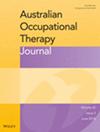Sensory processing in children with Paediatric Acute-onset Neuropsychiatric Syndrome
Abstract
Introduction
Previous research indicates that children with Paediatric Acute-onset Neuropsychiatric Syndrome (PANS) experience sensory reactivity differences that impact occupational performance. The purpose of this study was to determine whether there are differences in sensory reactivity in these children across two different time points; during exacerbation and during remission, using the Sensory Processing Measure (SPM) Home-Form. The study also sought to investigate whether children with PANS experience sensory differences during remission periods, when compared with SPM Home-Form norms.
Methods
A two-period bidirectional case-crossover design was used, and an online assessment was conducted to measure sensory reactivity. Parents of children aged 4.6 to 13.1 years with a diagnosis of PANS were recruited from various sites across Australia, USA, England, Ireland, Scotland, Canada, and New Zealand. The SPM Home-Form was used to measure sensory reactivity at two time points, when PANS was in remission (T-R) and in exacerbation (T-E). Study entry was permitted at either T-E or T-R. Participant exacerbation status was monitored over a maximum 12-month period, and a follow-up SPM Home-Form was sent when a change in exacerbation status was indicated. A linear mixed model was used to assess the difference between SPM Home-Form norm-referenced scores during exacerbation and remission.
Results
The study included 82 participants, with 80 providing data at study entry, and 27 providing data at follow-up. Results showed a statistically significant decline in performance across the SPM Home-Form domains of Hearing, Social Participation, Planning and Ideas, and Total Sensory Systems T-scores during exacerbation when compared with remission data. Results also demonstrated atypical sensory reactivity across Vision, Hearing, Touch, Balance and Motion, and Total Sensory Systems domains during periods of remission compared with SPM Home-Form norms.
Conclusion
This study found that children with PANS experience significant sensory reactivity differences during exacerbation and remission across multiple sensory domains, with a decline in performance during exacerbation. Where there are occupational performance challenges, occupational therapists should consider administering sensory assessments so that effective intervention plans addressing the unique sensory reactivity needs of children with PANS can be developed.

 求助内容:
求助内容: 应助结果提醒方式:
应助结果提醒方式:


